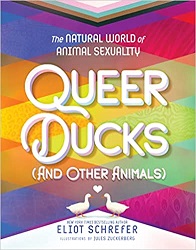
 Queer Ducks (And Other Animals)
Queer Ducks (And Other Animals)The Natural World of Animal Sexuality
Katherine Tegen Books (HarperCollins), 2022. 230 pages.
Review written February 22, 2023, from a library book.
Starred Review
2023 Michael L. Printz Honor Book
2023 Capitol Choices selection
2023 Sonderbooks Stand-out:
#2 Teen Nonfiction
Oh my goodness, I learned so much from this book! You've probably heard of the book And Tango Makes Three -- a book about two male penguins starting a family and hatching an egg together? Well, that's merely a drop in the bucket of same-sex relationships in the animal kingdom. In fact, "The number of species with confirmed substantial queer behaviors, published in well-regarded scientific journals, is 1,500 and growing."
The thing is? In the past, we didn't have an easy way to tell male and female penguins apart. Or the males and females of many species. So when scientists saw animals having sex or doing sexy things, they assumed they were looking at males and females. Well, now we have blood tests we can use to determine sex, and there's a whole lot more going on out there.
The entire book is fascinating and eye-opening, even for me, a straight cisgender woman. But because I have a transgender daughter and left a church that doesn't affirm LGBTQ people, I especially enjoyed the chapter on velvet-horned deer.
I already knew that many varieties of fish and frogs often change their gender. But I didn't know anything about velvet-horned deer.
As they grow from yearlings into adults, all male deer go through a "velvet" stage, in which their growing horns are covered by soft fuzz. As they reach sexual maturity, the velvet is generally shed, revealinng the bone antlers underneath. Some deer born with external male genitalia, though, never shed their velvet, and have bodies closer to those of female deer.
Known as velvet-horns, these intersex deer don't enter the pecking order of the rest of the deer society. In fact, they're soon driven out by the males. They skip the bachelor herds and the groups of mothers, and instead form their own troops of three to seven velvet-horns. Velvet-horns don't produce offspring, but live out healthy deer lives in their own velvet-horn societies.
Life as a velvet-horn sounds kind of awesome, actually. You hang out with your "found family" of like-minded deer, skip the work of birthing your own fawns, and avoid the deer-on-deer violence of the bachelor herds.
That's just part of the chapter about animals apparently outside the gender binary. But I wish I could show it to the pastor whose entire argument that being transgender is "against God's design" was because of a verse in Genesis that says God created them "male and female." Because God also created the animals "male and female" and it turns out that they aren't constricted by that. (Of course, God also made "day and night" -- and we still know about twilight. It was never even close to a good argument, but knowing what I know now, it got even worse.)
And I knew, from old "Wild Kingdom" TV shows, that many birds do elaborate courtship dances. What I didn't know is that some birds will do them to a member of the same sex and pair bond with them for life. In albatrosses, it's often the females who do this. They'll have some sex on the side to get eggs, and then they work together to raise the chicks -- and those two-mother "nest-holds" end up having better chick survival rates.
I can't even begin to tell all the stories of what I learned in this book. They're told in an engaging way and just completely surprised me. It turns out that animals of all kinds have lots of sex and a lot of it is not males and females making babies. Who knew?
The author of the book is gay, and grew up being told that was unnatural and twisted.
This is partly a book for lonely eleven-year-old Eliot, who only began to see himself as worthy of full respect many years after coming out. I thought that queerness separated me from the rest of the animal world, but came to love myself once I began to feel deep in my bones that being "unnatural" didn't automatically make me bad or wrong. That's still certainly true: there's no innate link between unnatural things and wrongness. After all, reading books could be considered "unnatural," but few people argue that it's bad. Regardless, the young Eliot would have had a quicker journey to self-acceptance if he'd known the science that's in this book.
I admit I giggled a little when I first checked out this book. Once I started reading, I was flat-out fascinated! It's not often I read a book so packed with scientific facts I didn't know before.
Here's a paragraph from the concluding chapter:
While the "why" of animal queerness is still a topic of productive and exciting scientific debate, the "that" of it -- the fact that animal queerness exists and is substantially represented in the natural world -- is unmistakable. There's an incredible diversity to animal sexual behavior and sexual expression, and each new piece of research in this exciting field has led to revelations that reshape what we assume animals are capable of -- and what humans themselves are capable of. Queer behavior in animals is as diverse and complex -- and natural -- as any other sort of sexual behavior.
It turns out that queer humans are not unusual after all, if you look at the wider animal kingdom. And that's a refreshing and eye-opening perspective.
Oh, and let me also mention that it's all told in a humorous and friendly tone, with cartoons at the front of each chapter portraying an animal GSA group. The book doesn't stir up lustful feelings, but it does stir up lots of scientific curiosity and wonder.
Learn some science! Read this award-winning book!
